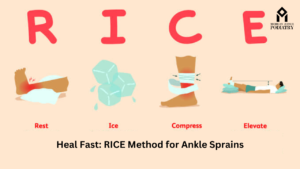Ankle sprains are one of the most common musculoskeletal injuries, affecting individuals of all ages and activity levels. Whether you’re an athlete or someone who enjoys recreational activities, understanding the ins and outs of ankle sprains is essential for timely treatment and successful recovery. In this comprehensive guide, we’ll cover ten crucial things you should know about ankle sprains, including their causes, symptoms, treatment options, and the role of podiatrists or foot doctors in managing this common injury.
-
What is an Ankle Sprain?
An ankle sprain occurs when the ligaments that support the ankle joint are stretched or torn due to sudden twisting or rolling of the foot. This can happen during sports activities, walking on uneven surfaces, or simply misstepping. Ankle sprains are graded based on the severity of ligament damage, ranging from mild (Grade I) to severe (Grade III) sprains.
-
Common Causes of Ankle Sprains:
The primary cause of ankle sprains is sudden, forceful twisting or rolling of the ankle, which can occur during activities such as running, jumping, or changing direction abruptly. Other factors that increase the risk of ankle sprains include uneven terrain, inadequate footwear, weak ankle muscles, and previous ankle injuries.
-
Signs and Symptoms of a Sprained Ankle:
The signs and symptoms of a sprained ankle may vary depending on the severity of the injury but commonly include pain, swelling, bruising, and difficulty bearing weight on the affected foot. Individuals may also experience instability or a sensation of giving way in the ankle joint.
-
Types of Ankle Sprains:
Ankle sprains can be classified based on the direction of the force that causes the injury. Inversion sprains, where the ankle rolls inward, are the most common type of ankle sprain. Eversion sprains, where the ankle rolls outward, are less common but can occur in certain situations, such as tripping over an object.
-
Immediate Treatment for Ankle Sprains:
The initial treatment for an ankle sprain, known as the R.I.C.E. protocol, includes rest, ice, compression, and elevation. Resting the affected ankle, applying ice packs to reduce swelling, using compression bandages to support the ankle, and elevating the foot above heart level can help alleviate pain and promote healing in the early stages of injury.
Also Read
-
Diagnosis of Ankle Sprains:
If you suspect you have an ankle sprain, it’s essential to seek evaluation from a healthcare professional, such as a podiatrist or foot doctor. They will perform a thorough physical examination, assess the range of motion and stability of the ankle joint, and may order imaging tests, such as X-rays or MRI scans, to confirm the diagnosis and rule out other injuries.
-
Treatment Options for Ankle Sprains:
The treatment approach for ankle sprains depends on the severity of the injury. Mild to moderate sprains may respond well to conservative treatments, such as rest, ice therapy, compression bandaging, and nonsteroidal anti-inflammatory drugs (NSAIDs) to manage pain and inflammation. Severe sprains or those associated with ligament tears may require immobilization with a brace or cast, physical therapy, or even surgical intervention in rare cases.
-
Rehabilitation and Prevention Strategies:
Once the acute symptoms of an ankle sprain have subsided, rehabilitation exercises are crucial for restoring strength, flexibility, and proprioception (sense of joint position) to the ankle joint. A physical therapist or podiatrist can design a tailored rehabilitation program to improve ankle stability, reduce the risk of recurrent sprains, and enhance overall function.
-
Returning to Activity Safely:
It’s essential to avoid returning to strenuous activities too soon after an ankle sprain, as this can increase the risk of re-injury and delay healing. Gradually reintroducing weight-bearing activities, sports-specific drills, and functional movements under the guidance of a healthcare professional can help ensure a safe and successful return to activity.
-
The Role of Podiatrists or Foot Doctors:
Podiatrists or foot doctors specialize in diagnosing and treating conditions affecting the feet and lower limbs, including ankle sprains. They play a crucial role in managing ankle sprains by providing comprehensive evaluation, accurate diagnosis, and individualized treatment plans tailored to the patient’s specific needs. Podiatrists can also offer advice on preventive measures, proper footwear, and techniques to reduce the risk of ankle sprains in the future.
Conclusion:
Ankle sprains are common injuries that can occur during various activities and have the potential to cause significant pain and functional impairment. By understanding the causes, symptoms, treatment options, and rehabilitation strategies for ankle sprains, individuals can take proactive steps to facilitate prompt healing and minimize the risk of complications. Seeking prompt evaluation and treatment from a podiatrist or foot doctor is essential for accurate diagnosis and personalized care tailored to the individual’s needs, ultimately promoting optimal recovery and long-term ankle health.




